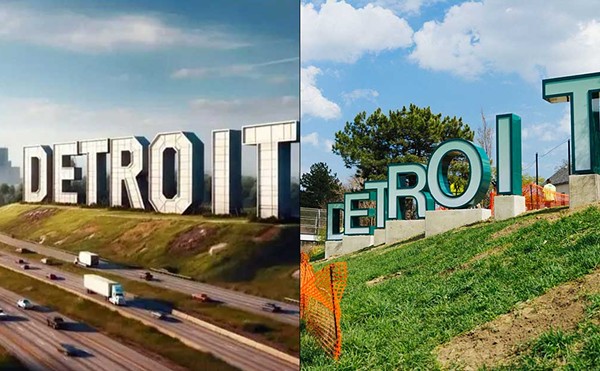Traveling around the Chadsey-Condon neighborhood on Detroit's west side, Chaunci Cline can point out entire blocks of homes she grudgingly admits need to be demolished.
The area may have already been struggling as the city's population dropped in recent decades, but now it's a casualty of the housing crisis as well — with vacant and abandoned properties that are dragging down property values, creating blight, and falling into such disrepair that renovation is not economically feasible.
Even Cline, executive director of Prevailing Community Development Corp., an ardent supporter of renovation, concedes many buildings in this neighborhood need to go. Her first priorities include the stretches of dilapidated homes near schools, where grass has grown knee-high, siding has peeled, and windows are broken or boarded-up. Cline considers the vacant homes a danger for the community — especially for children who walk near them to and from school.
"If we had a chance to prioritize how you stabilize a neighborhood, this would be a mecca," she says. "It's devastated. Demolition could have a significant impact."
Tearing down such structures is one of the priorities of a new federal program that's pouring $264 million into Michigan to deal with the continuing, rippling effects of the foreclosure crisis on neighborhoods.
Michigan's allocation is the third largest — behind California and Florida — under the nearly $4 billion U.S. Department of Housing and Urban Development Neighborhood Stabilization Program. The effort is funding projects aimed at offsetting some of the harmful effects that foreclosed and vacant properties have on neighborhoods, as well as increasing home ownership and redevelopment.
Southeast Michigan is receiving the bulk of the Michigan allocation — about $137 million, which will be specifically used for the purchase and redevelopment of foreclosed homes, rehabilitation of abandoned or foreclosed homes, establishment of land banks for foreclosed properties, demolition of blighted structures and redevelopment of demolished or blighted properties. Monies are also going to the Michigan State Housing Development Authority (MSHDA) and outstate communities, including Grand Rapids and Lansing.
To qualify, communities needed to already be receiving Community Development Block Grant monies, and then were scored according to a formula based on number of foreclosures, vacancies, rate of subprime loans, number of defaulted loans and other factors, says Kevin Vettraino, community and economic development planner at Southeast Michigan Council of Governments. If the formula determined communities would receive at least $2 million by the program's guidelines, they were funded. A second round of funding — dubbed "NSP 2" — is taking applications this month from nonprofits and municipalities that didn't qualify in the first round.
"The national program is really targeted for the urban areas that have seen the old housing stock, the abandonment, the run-down, blighted neighborhoods," Vettraino says.
To actually receive money, communities needed HUD approval for their plans, which have been finalized and are available online. Nationally, a study of the NSP plans done by the Enterprise Institute found that allocations overall went 56 percent for purchase and rehabilitation, 21 percent for homebuyer finance, 13 percent for property redevelopment, 6 percent for blighted structure demolition and 4 percent for land banks.
Michigan communities have a mixture of priorities, but generally higher allocations for demolition than the national average, a Metro Times review of plans found. The areas have more vacant homes because of older housing and the earlier onset of the housing crisis here.
"We've been on the leading edge of foreclosures in the nation for the last four years," says Martha Baumgart, a planner with the Michigan State Housing Development Authority. "Every city has a different twist of what they're trying to do."
Throughout Michigan, the NSP funds are being used in different ways to redevelop, re-create and reassess housing. For example, MSHDA will re-allocate funds to communities throughout the state. About $32 million will be used to develop affordable rental housing for families earning less than half the median income for an area.
"The housing market right now is quite soft," Baumgart says. "Most people who are at or below that 50 percent of median income have an easier time renting than affording housing payments."
In Macomb County, about $680,000 of the county's $9.8 million allocation will be used to demolish 65 homes. But about $8 million is going toward the homebuyer acquisition program, says Mike Rozny, manager of community development in Macomb County.
Under the program, buyers who don't currently own homes (but aren't necessarily first-time buyers) can receive down-payment assistance and loans to rehabilitate foreclosed properties they purchase. As much as 49 percent of the total project costs — the amount to purchase the property and the costs of renovating it — could be forgiven if the buyer lives there for 15 years. A homebuyer could receive $95,000 of benefits in the program, according to Rozny. "It's nothing to sneeze at," he says. About 200 families have already applied.
In Pontiac, the city's $3.5 million is a mixture of demolition — about 50 structures will be demolished — and rebuilding efforts. Part of the plan includes the city paying for construction of eight "green" homes. Another part of the allocation will provide as much as $20,000 in down-payment assistance for buyers, says Patricia Lile, block grant administrator.
Detroit's plan for the city's $47 million NSP allocation includes about $4.3 million for new construction and about $14 million for rehabilitation. The city also plans to spend about $14 million on demolition.
Last year, as Detroit was formulating its plan for using NSP funds, the city took public comments and held public hearings. Cline was there.
"We went to the City Council about using the NSP dollars to tear down properties that were along school routes," she says. "I would deal with this demolition issue to make areas safer for the community."
Cline plans to have Prevailing Community Development Corp. apply for the second round of NSP grants. Applications are due later this month.
"We're looking at rehabbing some in-fill housing to help strengthen the economic base," Cline says. "There's a reason to build this community. It's an investment."
To link to the finalized NSP plans, see tinyurl.com/ncfw7j.
Allocations of National Stabilization Program funds in southeast Michigan
Canton Township $2.2 million
Clinton Township $2.1 million
Dearborn $2.4 million
Detroit $47.0 million
Lincoln Park $2.4 million
Pontiac $3.5 million
Redford $3.0 million
Southfield $3.2 million
Sterling Heights $2.5 million
Taylor $2.5 million
Warren $5.8 million
Waterford Township $2.0 million
Westland $2.1 million
Macomb County $9.8 million
Oakland County $17.3 million
Washtenaw County $3.0 million
Wayne County $25.9 million
Source: U.S. Department of Housing and Urban Development
Sandra Svoboda is a Metro Times staff writer. Contact her at 313-202-8015 or [email protected]




